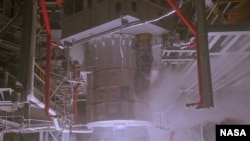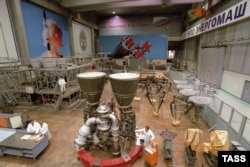This is not the first time Russia has threatened to block the export to the United States of Russian engines for booster rockets. In May 2014, Deputy Prime Minister Dmitry Rogozin, who was overseeing the space industry, said that Russia might suspend supplying the U.S. with RD-180 rocket engines in response to U.S. sanctions “if they were going to be used for non-civilian purposes.” However, Russia ultimately didn’t suspend [export of the rocket engines], and another Atlas V launch vehicle fitted with precisely that Russian engine was used to launch two military satellites into orbit on April 15.
This story began over 20 years ago. In July 1997, an American corporation, Lockheed Martin, signed an agreement with the Russian rocket engine manufacturer NPO Energomash to buy 101 RD-180 rocket engines for an overall amount of about $1 billion. They were supposed to be used in American launch vehicles to put satellites into orbit.
“We selected the RD-180 not only for its reliability and effectiveness but for the low price and short production times,” said the then-director of the aerospace unit of Lockheed Martin. Their use in the launch vehicles that the company manufactured, according to the same director, made it possible to reduce the total number of engines in the rockets from nine to two.
Russian engines are at least 10% more effective than their American analogs, a director of the Pratt & Whitney Corporation had said a year earlier. That company also participated in the agreement.
The first launch of an American Atlas III booster rocket using Russia’s RD-180 engine (there were six such launched before production of the rocket was phased out) took place in May 2000, and the currently used Atlas V debuted in August 2002. Since then, Atlas Vs have been launched 77 times, and all of the launches have been successful. NPO Energomash says that it supplied in total “over 80 RD-180 commercial engines (as of May 15, 2016)” to the United States.
In the last 11 years, United Launch Alliance (ULA), a joint venture of Lockheed Martin and Boeing that merged their aerospace departments in 2006, has been the main buyer of the engines.
According to the original plan, Pratt & Whitney was supposed to move production of the engines to the United States by 2008. However, the deadline was moved to 2012 at some point, and two main arguments dominated: “localization” of production would require an additional roughly $1 billion, and secondly, setting up local production would take no less than five years. As a result, a decision was made to continue importing the RD-180 from Russia.
However, in December 2014 the U.S. Congress put in place a ban on purchases of Russian engines for military and observation satellites as part of the sanctions against Russia for its annexation of Crimea and intervention in eastern Ukraine. The ban didn’t cover contracts that had already been negotiated and were set to expire by 2019. A year later, in December 2015, the ban was essentially lifted and, just a few days later, ULA announced plans to buy 20 more Russian engines.
Factograph had already given detailed accounts about domestic American research and development of own engines for launch vehicles, but one of the main questions remains the timing of the start of their actual operation. In particular, tests by ULA of its own new engine are expected to be completed no earlier than 2019, while tests of the new Vulcan launch vehicle will only be completed by 2022-2023.Therefore, as the Wall Street Journal noted last September, the United States may continue to buy the RD-180 from Russia through the middle of the next decade.
But RD-180 is not the only product made by Russia’s NPO Energomash that the United States purchases. In December 2014, an American aerospace company, Orbital ATK, signed an agreement that not only included the purchase of 20 RD-181 engines, but also options for another two purchases , each one of them for another 20 engines. In total the project is worth an estimated $1 billion. Orbital ATK is using these engines on its Antares rockets, which are used to deliver supplies to the International Space Station (ISS). According to NPO Energomash, deliveries of RD-181 engines to the United States started in June 2015.
A cost of a rocket engine is proprietary information but expert estimates do not differ greatly on this issue. According to one estimate, an RD-180 engine is worth $11-15 million; others say it’s about $10 million. But if NPO Energomash sold the United States nine RD-180 engines in 2014-2015, then those sales could total $100 million annually. That matches the estimates of some American experts.
If these exports to the United States stop, it will create financial difficulties for NPO Energomash. Just the RD-180 sales alone accounted for half of its total revenues in 2015. The research director of the Russian Institute of Space Policy, Ivan Moiseyev, said four years ago: “It is foolish to end exports of the rocket engine to the United States. It is clear that Americans won’t suffer from it a lot and won’t stop launching military satellites because of it. And we will have to end RD-180 production because nobody will need those engines anymore.”
However, the Russian Ambassador to China said in August 2016 that Moscow was negotiating with Beijing about selling rocket engines to China. NPO Energomash confirmed to the Financial Times this past January that the negotiations with China were continuing.
The technology behind the RD-180 goes back to 40-year-old designs. However, Chad Ohlandt, a senior engineer at the RAND Corporation, told the Financial Times that it is three times more powerful than the YF-100, China’s most modern engine. Rick Fischer, an expert in rocket technology in International Assessment and Strategy Center in Washington D.C., told the newspaper: “Russia can’t deny understanding that China is planning to obviously push them aside in this market.”
Three months ago, Russian Security Council Secretary Nikolay Patrushev said that Russia would continue to supply RD-180 engines to the United States despite the new U.S. sanctions. “We behave correctly towards other states and fulfill those agreements we agreed to. I don’t think we need to stop deliveries of those engines. I think that we will continue them.”
And Deputy Prime Minister Dmitry Rogozin said earlier that although “NPO Energomash has solid contracts through 2020,” there is a high probability that the RD-180 and RD-181 rocket engines can be supplied to the United States after that as well.
Stopping the deliveries of these engines to the United States will seriously cut NPO Energomash’s profits. Russian Institute of Space Policy research director of Moiseyev warned last fall that the company was already not very busy that business could get really slow. He again warned that any sanctions in the space industry will hurt Russia badly while the United States “won’t feel them at all.”
Adapted from the RFE/VOA Russian language fact check, Factograph.info: https://www.factograph.info/a/29173062.html







